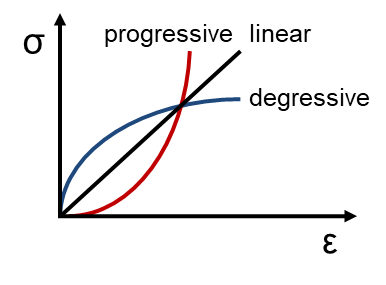

The aim of the project is to create passive load alleviation with nonlinear elastic materials. The idea is increasing the performance during low load cases around cruise and decreasing the loading of high load cases. In other words, the wing shall be stiff during cruise and gets more flexible at high loading cases.
To examine this, an iterative process computes trimmed, quasi-steady manoeuvres. In doing so, the process considers the aeroelastic coupling. It iteratively calculates loads and deformations, using the vortex lattice method for the aerodynamic analysis and a finite element model for the nonlinear structural analysis.
An essential requirement of aeronautic structures is their lightweight design. Such characteristic yields a considerable susceptibility to vibrations, affecting the controllability of an aircraft. In order to encounter transient events, such as gust encounter or landing impact, a rapid decay of vibrations achieved with proper placement of dampers would help to passively alleviate dynamic loads. Based on finite element modelling, tools will be developed that enable the damping analysis of vibrating structures supplemented with local viscoelastic dampers. Additionally, an optimization algorithm will be evolved, focusing on the integration positions to achieve maximum damping increase for loads critical modes with minimal impact on structural weight.
A special property of viscoelastic materials is the frequency and temperature dependence of their material parameters. One rheological model which describes the mechanical behavior of viscoelasticity is the generalized Maxwell model. At different excitation frequencies, both the stiffness and the damping capability of the material can vary significantly. Therefore, to evaluate the influence of local viscoelastic elements on a global structure regarding eigenfrequencies and damping ratios, it is necessary to solve an eigenvalue problem with frequency dependent stiffness and damping matrices. The frequency dependence avoids a direct calculation and requires an iterative solution algorithm.
Procedures for an increase of the damping effectiveness include the deliberate generation of shear strain in viscoelastic materials. A common application for vibration damping which utilizes this effect is the Constrained Layer Damping treatment (CLD), where a viscoelastic core layer is constrained between the stiffer base structure and a stiffer face layer. Occurring bending vibrations force the viscoelastic layer under shear strain. Since aircraft vibrations cover a wide range of different frequency and temperature ranges during operation, the damping material has to cope with the corresponding influences. Due to the dependence on frequency and temperature of viscoelastic material properties, the damping performance will also vary during operation.
One of the main challenges in aeronautic manufacturing is to design structures which comply with stiffness requirements and maximum mass limits at the same time. Therefore, the overall objective in terms of viscoelastic damping design will be to develop an optimization tool which aims to deliver highest damping with lowest mass increase. The optimization tool will optimize several design variables like the positioning or the topology of the viscoelastic and face layer, in order to create a tailored geometry for particular mode damping.